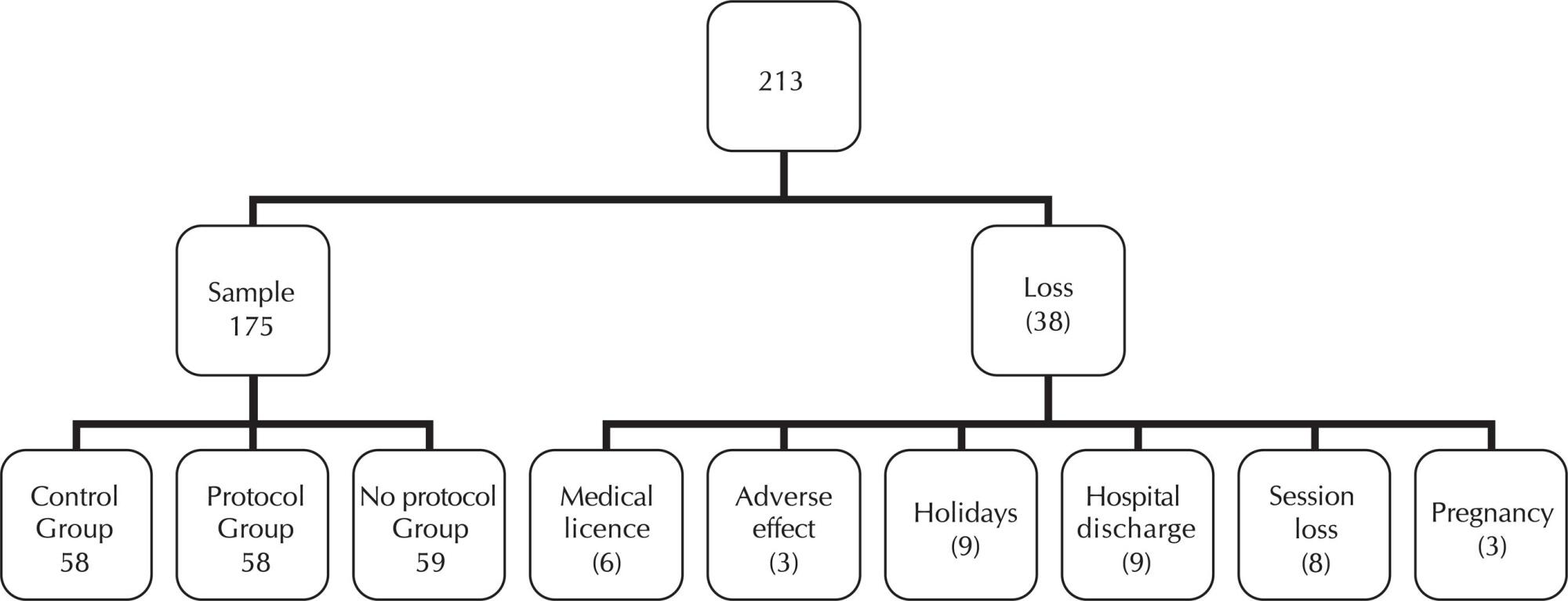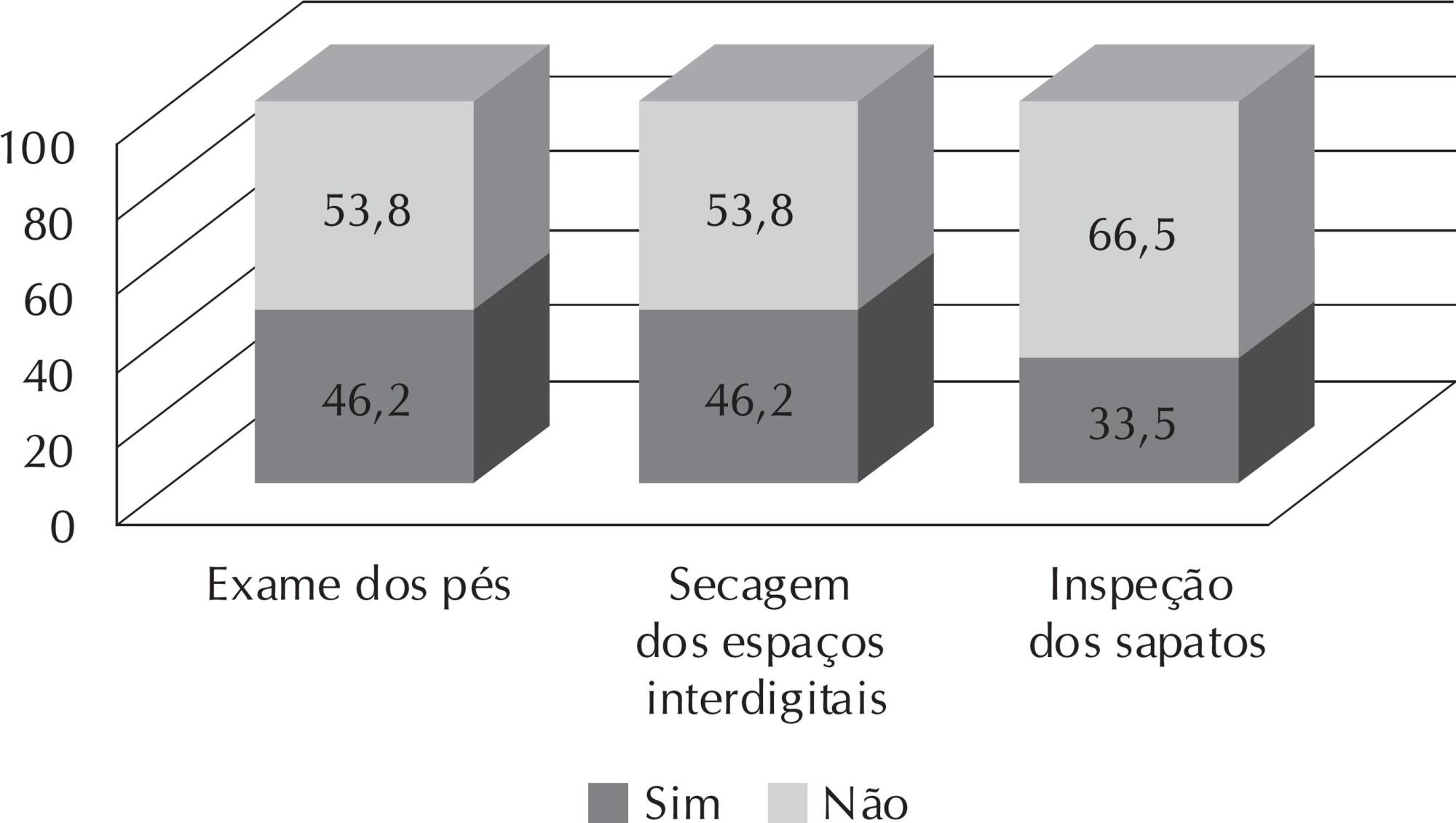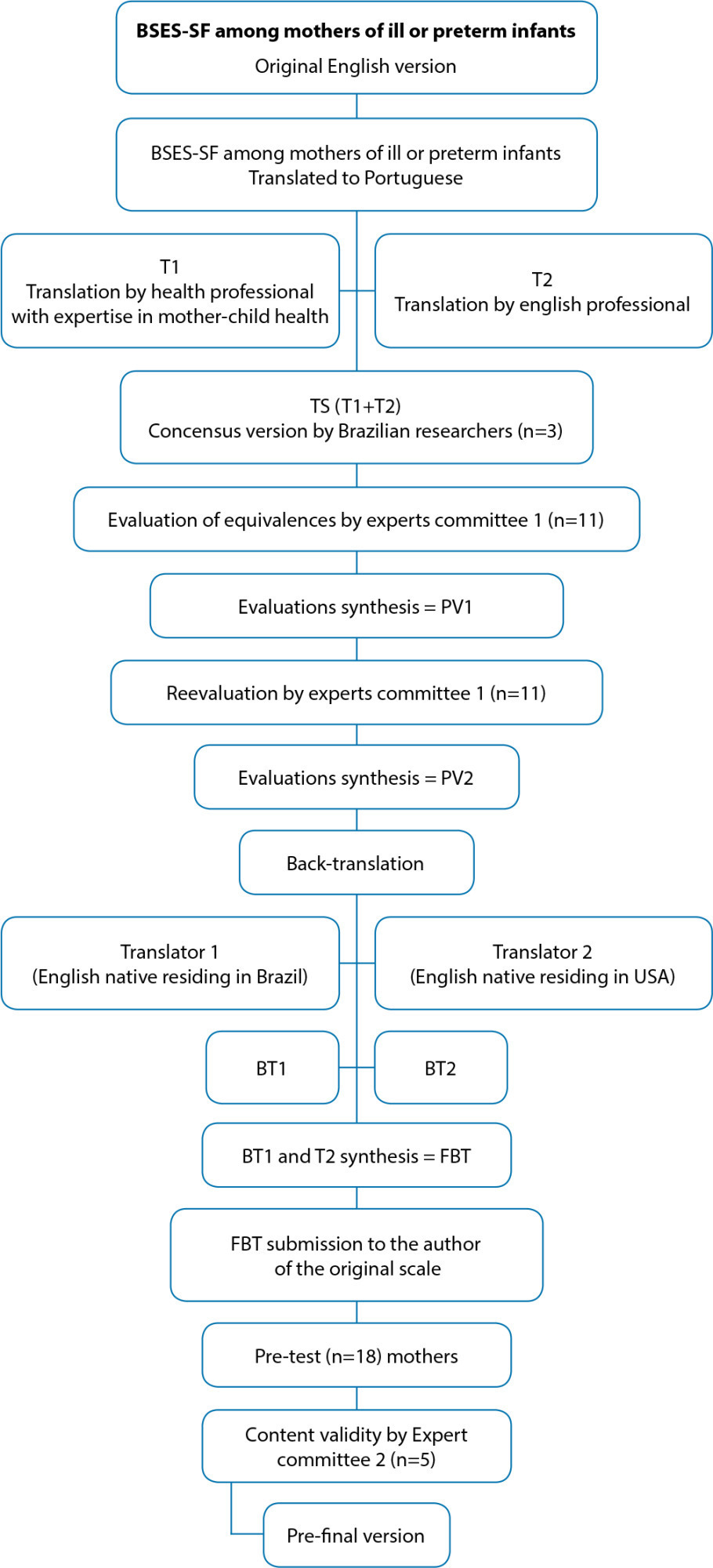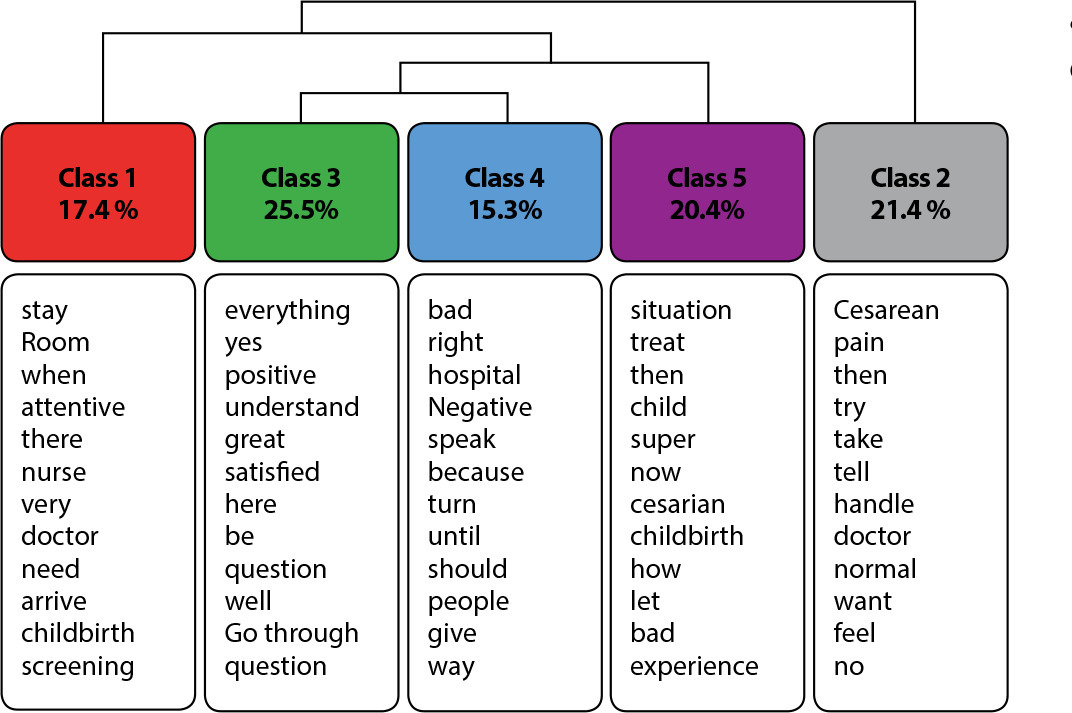-
RESEARCH01-01-2016
Nasal colonization with Staphylococcus aureus in nursing students: ground for monitoring
Revista Brasileira de Enfermagem. 2016;69(6):1046-1051
Abstract
RESEARCHNasal colonization with Staphylococcus aureus in nursing students: ground for monitoring
Revista Brasileira de Enfermagem. 2016;69(6):1046-1051
DOI 10.1590/0034-7167-2016-0210
Views0See moreABSTRACT
Objective:
to monitor bacterial strains of Staphylococcus aureus that are resistant or not to oxacillin in nursing undergraduate students, with an emphasis on the process of colonization.
Method:
cross-sectional prevalence study carried out with 138 nursing students. The biological samples of the nasal cavity were collected in June 2015, by means of sterile swabs, which were subsequently submitted to confirmatory tests of catalase and coagulase. Isolated Staphylococcus aureus had their sensitivity profile determined by means of the Kirby Bauer method. Descriptive, univariate and bivariate analyses were performed.
Results:
the prevalence of Staphylococcus aureus was 21.7. Regarding the resistance profile, 24.1% of strains were resistant to oxacillin, with ampicillin being the antimicrobial with the greatest resistance (82.8%).
Conclusion:
the nasal cavity is an important bacterial flora of S. aureus in nursing students. The profile of isolated strains highlights the increase of Staphylococcus aureus resistance to antimicrobials such as oxacillin.
-
RESEARCH01-01-2016
Factors associated with the occurrence of adverse events in critical elderly patients
Revista Brasileira de Enfermagem. 2016;69(6):1039-1045
Abstract
RESEARCHFactors associated with the occurrence of adverse events in critical elderly patients
Revista Brasileira de Enfermagem. 2016;69(6):1039-1045
DOI 10.1590/0034-7167-2016-0199
Views0See moreABSTRACT
Objective:
to identify the factors associated with the occurrence of adverse events in critical elderly patients admitted to intensive care unit according to demographic and clinical characteristics.
Method:
a retrospective cohort study was conducted in nine units of a teaching hospital. Data were collected from medical records and from monitoring of nursing shift change. We used the t-test/Mann-Whitney, chi-square and logistic regression to test associations. Significance level of 5% was used.
Results:
out of the 315 elderly, 94 experienced events. Those who experienced events were men (60.6%) with mean age of 70.7 years, length of hospital stay of 10.6 days and survivors (61.7%). Most of the 183 events were clinical processes and procedures (37.1%). There was an association between adverse event and length of hospital stay in the unit (p=0.000; OR=1.10, 95% CI [1.06, 1.14]).
Conclusion:
the identification of associated events and factors in the elderly subsidize the prevention of these occurrences before the vulnerability of this age group.
-
RESEARCH01-01-2016
Challenges to implementation of advance directives of will in hospital practice
Revista Brasileira de Enfermagem. 2016;69(6):1031-1038
Abstract
RESEARCHChallenges to implementation of advance directives of will in hospital practice
Revista Brasileira de Enfermagem. 2016;69(6):1031-1038
DOI 10.1590/0034-7167-2016-0085
Views0See moreABSTRACT
Objective:
to understand the difficulties and limitations in the implementation of advance directives of will in the hospital context.
Method:
qualitative, exploratory and descriptive study conducted by means of semi-structured interviews with nurses, resident physicians and family caregivers. The data were analyzed by using discursive textual analysis based on the framework of bioethics principles.
Results:
the following categories emerged: Terminality as an expression of loss and cure as an option for care; concerns about legal implications; advance directives of will demand patient autonomy and proper communication.
Conclusion:
limitations and difficulties in practice of advance directives of will from the perspective of the participants show, apart from countless conflicts and dilemmas regarding end-of life matters, that impending death experiences obstruct patients’ wishes.
-
RESEARCH01-01-2016
Experience and coping strategies in relatives of addicts
Revista Brasileira de Enfermagem. 2016;69(6):1024-1030
Abstract
RESEARCHExperience and coping strategies in relatives of addicts
Revista Brasileira de Enfermagem. 2016;69(6):1024-1030
DOI 10.1590/0034-7167-2015-0044
Views0See moreABSTRACT
Objective:
to understand the experience and coping strategies in relatives of drug addicts.
Method:
a study was developed with 87 relatives of addicts, registered in two Basic Health Units. The focus group was used as the study method, and content analysis was applied.
Results:
four categories were chosen: perception of relatives about the drug addiction of their family members; feelings and attitudes related to being a relative of an addict; difficulties found in the process; and, coping strategies. The findings reflected the difficulty when mentioning the subject, and the need of being cared for. Relatives believed that the addict needs to have the will to get into treatment, and they faced challenges in dealing with sporadic disappearances. They pointed to feelings of pity, impotence, disgust, hate, shame, fear of aggressiveness, and humiliation.
Conclusion:
the biggest difficulties were dealing with relapses, and the lack of public resources. Religiosity and faith, isolation and advice were used as coping strategies; ambivalence in thoughts and attitudes was demonstrated.
-
RESEARCH01-01-2016
Leadership and cooperation: 25 years of mission as a WHO collaborating center
Revista Brasileira de Enfermagem. 2016;69(6):1017-1023
Abstract
RESEARCHLeadership and cooperation: 25 years of mission as a WHO collaborating center
Revista Brasileira de Enfermagem. 2016;69(6):1017-1023
DOI 10.1590/0034-7167-2016-0058
Views0See moreABSTRACT
Objective:
analyse the evolution in the mission and vision of a World Health Organization Collaborating Centre in Nursing in Brazil in the context of the implementation of its terms of reference.
Method:
Historical-social documentary research with a qualitative approach.
Results:
During the 25 years of its activities as a Collaborating Centre, its mission to “promote and stimulate the development of nursing research in the region, with a focus on Latin America” triggered activities in the context of its terms of reference in four areas: Human Resource Formation for Research, Knowledge Production, Knowledge Dissemination, Encouragement of Exchange and Stimulus of Partnerships.
Conclusion:
The activities developed were consolidated through the strengthening of Brazilian and international partnerships, further stimulated by the five redesignations of the Collaborating Centre in the period analysed. Thus, its vision of becoming leader and driving agent of innovations in the academic, care and political context of nursing could be put in practice.
-
EDITORIAL01-01-2016
ABEn 90 years and the Brazilian Journal of Nursing
Revista Brasileira de Enfermagem. 2016;69(6):1011-1012
Abstract
EDITORIALABEn 90 years and the Brazilian Journal of Nursing
Revista Brasileira de Enfermagem. 2016;69(6):1011-1012
Views0In this special edition, we celebrate 90 years of the Brazilian Nursing Association (ABEn), at the same time in which we celebrate the creation and maintenance of the first scientific nursing journal in Brazil. Emerging in 1932, it has shone a light on the production of knowledge and the constitution of nursing in Brazil today.As […]See more -
EDITORIAL01-01-2016
ABEn 90 anos e a Revista Brasileira de Enfermagem
Revista Brasileira de Enfermagem. 2016;69(6):1011-1012
Abstract
EDITORIALABEn 90 anos e a Revista Brasileira de Enfermagem
Revista Brasileira de Enfermagem. 2016;69(6):1011-1012
Views0Neste número temático, celebramos os 90 anos da Associação Brasileira de Enfermagem (ABEn), ao mesmo tempo em que comemoramos a criação e manutenção da primeira revista científica de enfermagem do Brasil, que, desde 1932, despontou trazendo luz para a produção do conhecimento e a constituição do que é a enfermagem no Brasil atual.A ABEn, como […]See more -
ERRATUM01-01-2016
ERRATUM
Revista Brasileira de Enfermagem. 2016;69(5):1003-1003
Abstract
ERRATUMERRATUM
Revista Brasileira de Enfermagem. 2016;69(5):1003-1003
DOI 10.1590/0034-7167.20166905e02
Views1Article “Association between self-care and hospital readmissions of patients with heart failure”, with number of DOI: 10.1590/0034-7167.2016690312i, published in the journal Revista Brasileira de Enfermagem, v69(3):469-74, page 469 that read:“Amanda Chlalup LinnI, Karina AzollinII,III, Emiliane Nogueira de SouzaII,IV“.[…]See more
-
REVIEW01-01-2015
Adverse events and safety in nursing care
Revista Brasileira de Enfermagem. 2015;68(1):144-154
Abstract
REVIEWAdverse events and safety in nursing care
Revista Brasileira de Enfermagem. 2015;68(1):144-154
DOI 10.1590/0034-7167.2015680120i
Views0See moreObjective:
to identify the scientific publications about adverse events in nursing care in adult hospitalized patients and discuss the main adverse events in nursing care.
Method:
Integrative revision with a qualitative approach. The data were collected at LILACS, MEDLINE, BDENF and the library SCIELO and were submitted to thematic analysis.
Results:
three categories were developed: Adverse events in nursing care; The main causes of the adverse events in nursing care; Attitude of nursing professionals in face of errors. The main events were identified in nursing care with emphasis on the medication error, the failure to perform dressings and falls of patients. The importance of instruments was emphasized for notification of adverse events in the institutions. However the fear of punishment on professionals stimulates the underreporting of events.
Conclusion:
it is important to discuss effective prevention strategies that ensure patient safety in healthcare institutions.
-
REVIEW01-01-2015
Staphylococcus aureus meticilino resistente adquirido na comunidade: um problema mundial
Revista Brasileira de Enfermagem. 2015;68(1):136-143
Abstract
REVIEWStaphylococcus aureus meticilino resistente adquirido na comunidade: um problema mundial
Revista Brasileira de Enfermagem. 2015;68(1):136-143
DOI 10.1590/0034-7167.2015680119p
Views0Objetivo:
descrever a epidemiologia dos casos de CA-MRSA no Brasil de forma a compreender sua ocorrência, fatores de risco associados e formas de manejo em relação à situação mundial.
Método:
revisão integrativa e para seleção dos estudos utilizou-se as bases de dados: Scopus, Science direct, Isi Web of Knowledge, PUBMED e BVS.
Resultados:
foram identificados dez artigos nacionais que descreveram 21 casos de CA-MRSA principalmente em crianças, adolescentes e adultos com quadro de infecção de pele e tecidos moles evoluindo para infecções graves relacionados ao clone Oceania Southwest Pacific Clone (OSPC) que resultaram em hospitalização.
Conclusão:
apesar do CA-MRSA ser considerado um micro-organismo de relevância mundial verificou-se a escassez de dados publicados sobre sua epidemiologia no Brasil, o que dificultam o delineamento da realidade do país frente ao CA-MRSA.
Keywords:Controle de InfecçõesFarmacorresistência BacterianaInfecções Comunitárias AdquiridasStaphylococcus Aureus Resistente à MeticilinaSee more -
REVIEW01-01-2015
Prevention and non-pharmacological management of pain in newborns
Revista Brasileira de Enfermagem. 2015;68(1):131-135
Abstract
REVIEWPrevention and non-pharmacological management of pain in newborns
Revista Brasileira de Enfermagem. 2015;68(1):131-135
DOI 10.1590/0034-7167.2015680118i
Views0See moreObjective:
to describe the main non-pharmacological interventions for pain relief in newborns available in Neonatal Intensive Care Unit.
Method:
an exploratory search of the MedLine, Lilacs and Scielo online databases was conducted to retrieve references of studies published from 2004 to 2013.
Results:
several non-pharmacological interventions were shown to be effective, to represent low risk for neonates and to have a low operational cost. The ones most often discussed in the literature were: oral administration of glucose/sucrose, non-nutritive sucking, breastfeeding, skin-to-skin contact, facilitated tucking and swaddling.
Conclusion:
healthcare teams should be familiar with these methods and use them more effectively in Neonatal Intensive Care Unit daily routines, so as to ensure that newborns receive qualified and more human care.
-
BANFISA e (IN)DICA-SUS na graduação em saúde: o lúdico e a construção de aprendizados
Revista Brasileira de Enfermagem. 2015;68(1):124-130
Abstract
BANFISA e (IN)DICA-SUS na graduação em saúde: o lúdico e a construção de aprendizados
Revista Brasileira de Enfermagem. 2015;68(1):124-130
DOI 10.1590/0034-7167.2015680117i
Views0See moreObjectives:
to analyze the learning built during the matches of the games by students of the subject Gestão de Políticas Públicas em Saúde at the Universidade de Brasília.
Method:
exploratory, descriptive research, in a qualitative approach, with 26 students from various graduation courses in health, using a questionnaire and participant observation.
Results:
participants reinvented rules, related issues addressed in the games to the reality, interacted with colleagues and had fun throughout the match. Comparing the games in relation to ludicity, the BANFISA was more attractive than the (IN) DICA-SUS, although they are complementary.
Conclusions:
learning constructed by the students goes beyond the content of the subject; involve the active participation in group and creativity.
-
Chinese auriculotherapy to improve quality of life of nursing team
Revista Brasileira de Enfermagem. 2015;68(1):117-123
Abstract
Chinese auriculotherapy to improve quality of life of nursing team
Revista Brasileira de Enfermagem. 2015;68(1):117-123
DOI 10.1590/0034-7167.2015680116p
Views0See moreObjective:
to evaluated the effi cacy of auriculotherapy for improving quality of life and reducing stress in nursing staff.
Method:
single-blind radomizad clinical trail envolving 175 subjects randomized in: Control (G1), Protocol Group (G2) and without Protocol Group (G3). They were evaluated by the Stress Symptoms List and SF36v2 at baseline, after 12 sessions and follow up (30 days), between January and July 2012.
Results:
both intervention groups reduced stress (p <0.05) with greater effect for G3 (d = 1.15). G3 was also higher for improving life quality especially the physical domain (p = 0.05).
Conclusion:
individualized auriculotherapy (G3) had greater effect compared to the protocol auriculotherapy (G2) for reducing stress and improving life quality.

-
Adherence to foot self-care in diabetes mellitus patients
Revista Brasileira de Enfermagem. 2015;68(1):111-116
Abstract
Adherence to foot self-care in diabetes mellitus patients
Revista Brasileira de Enfermagem. 2015;68(1):111-116
DOI 10.1590/0034-7167.2015680115p
Views0See moreObjective:
to analyze the self-care of patients with type 2 diabetes mellitus in the Family Health Strategy in Teresina-PI.
Method:
search cross selected by simple random sampling, 331 people with diabetes mellitus. Data collection took place from August to December 2012 with the use of Self-Care Activities Questionnaire with Diabetes and structured instrument for recording information socioeconomic and guidance received by the professional nurse.
Results:
the data revealed that patients have poor adherence to blood glucose monitoring, the physical exercise and foot care, but with good adherence to the medication. Only 38.7% of the sample examined the feet of fi ve to seven days a week. Statistically signifi cant association between self-care activities with their feet and orientations of nurses (p < 0,05).
Conclusion:
that there is need to raise awareness with regard to the development of skills for self-care.

-
Patients with disorders of consciousness: vital, facial and muscular responses to music or messages
Revista Brasileira de Enfermagem. 2015;68(1):102-110
Abstract
Patients with disorders of consciousness: vital, facial and muscular responses to music or messages
Revista Brasileira de Enfermagem. 2015;68(1):102-110
DOI 10.1590/0034-7167.2015680114p
Views0See morePurposes:
to compare vital signs, facial expression and basal electroneurographic signs with measures during stimuli music, message or “silence” in coma patients, vegetative status or sedated; and relating the score of Glasgow Results Scale with the intervention realized.
Method:
a Monoblind Transversal Controlled Clinical Trial to researcher. The distribution, among the three groups, was randomized (experiment with music, experiment with message or control). Two assessments (sessions) were performed with interval of 40 minutes on the same day.
Results:
most of the 76 patients were male, between 18 to 36 years old and hospitalized due to trauma. Statistically signifi cant changes were found in the variables referred to temperature, facial expression, electroneurography and Glasgow Results Scale; more frequent alterations in second session, in coma and vegetative patients, in frontal muscles and in experiment group.
Conclusions:
the facial expression and the electroneurography seem to be more trustworthy variables than vital signs to evaluate consciousness.
-
Prevalence of minor psychiatric disorders in socio-educational agents in the state of Rio Grande do Sul
Revista Brasileira de Enfermagem. 2015;68(1):93-101
Abstract
Prevalence of minor psychiatric disorders in socio-educational agents in the state of Rio Grande do Sul
Revista Brasileira de Enfermagem. 2015;68(1):93-101
DOI 10.1590/0034-7167.2015680113p
Views0See moreObjective:
to determine the prevalence and factors associated with minor psychiatric disorders (MPD) in socio-educational agents.
Method:
it is a cross-sectional study with 381 socio-educational agents the Centers for Socio-Educational Services in the State of Rio Grande do Sul, Brazil. The Brazilian versions of the Scale of Demand-control-social support at work and the Self Reporting Questionnaire-20 have been applied.
Results:
the results showed a prevalence of suspicion MPD of 50.1%. They showed to be related to suspicion of MPD : being female (55.7%), having age up to 44 years old (58.5%), no physical activity (57.4%), do not have time for leisure (75%), make use of medication (61.4%), require medical attention (56.9%) and psychological counseling (72.7%), not being satisfied with the workplace (61.7%) and need for time off from work (65.6%).
Conclusion:
the study provides important data about the mental health of agents, showing the need for the involvement of managers and of the health service of worker’s health in planning actions to promote health of these workers.
-
ORIGINAL ARTICLE11-27-2023
Incidents in the context of pre-hospital care by ambulances: contributions to patient safety
Revista Brasileira de Enfermagem. 2023;76(5):e20220657
Abstract
ORIGINAL ARTICLEIncidents in the context of pre-hospital care by ambulances: contributions to patient safety
Revista Brasileira de Enfermagem. 2023;76(5):e20220657
DOI 10.1590/0034-7167-2022-0657
Views0See moreABSTRACT
Objectives:
to analyze the occurrence of incidents in the context of mobile terrestrial pre-hospital care.
Methods:
a descriptive research was carried out through the observation of 239 treatments performed by 22 healthcare professionals at the Mobile Emergency Care Service, located in Baixada Fluminense, Rio de Janeiro, Brazil. Fisher’s exact test and chi-square test were used for data analysis.
Results:
the total time dedicated to patient care was 439.5 hours, during which 2386 security incidents were observed. The most notable ones were related to written communication (235), patient identification through bracelets (238), and safety in medication preparation (81).
Conclusions:
the need to promote and implement initiatives aimed at patient safety is evident, with special focus on international safety goals within the scope of mobile pre-hospital care services.

-
ORIGINAL ARTICLE11-27-2023
Saberes do enfermeiro e comunicação terapêutica no hospital
Revista Brasileira de Enfermagem. 2023;76(5):e20220617
Abstract
ORIGINAL ARTICLESaberes do enfermeiro e comunicação terapêutica no hospital
Revista Brasileira de Enfermagem. 2023;76(5):e20220617
DOI 10.1590/0034-7167-2022-0617
Views0See moreRESUMEN
Objetivos:
identificar la correlación entre el conocimiento de los enfermeros y la aplicación de la comunicación terapéutica de los enfermeros en los hospitales.
Métodos:
estudio descriptivo, cuantitativo, correlacional con método de muestreo total. Los encuestados fueron 68 enfermeros que trabajaban en una sala del hospital. Se utilizaron cuestionarios modificados para recopilar datos. Los datos se analizaron mediante el análisis de la prueba de chi-cuadrado de Pearson.
Resultados:
los enfermeros con conocimientos suficientes y pobres tienen una buena aplicación de la comunicación terapéutica. No hubo correlación entre el conocimiento y la aplicación de la comunicación terapéutica.
Conclusiones:
la comunicación terapéutica está influenciada por muchos factores. El conocimiento de los enfermeros debe ser mantenido y mejorado para brindar una atención integral y aumentar la satisfacción del paciente.
-
ORIGINAL ARTICLE11-27-2023
Nurses’ knowledge and therapeutic communication in hospital
Revista Brasileira de Enfermagem. 2023;76(5):e20220617
Abstract
ORIGINAL ARTICLENurses’ knowledge and therapeutic communication in hospital
Revista Brasileira de Enfermagem. 2023;76(5):e20220617
DOI 10.1590/0034-7167-2022-0617
Views0See moreABSTRACT
Objectives:
to identify the correlation of nurses’ knowledge with the application of nurses’ therapeutic communication in hospitals.
Methods:
a descriptive quantitative, correlational design with a total sampling method was used in the study. Respondents were 68 nurses working in an inpatient room in one of the general hospitals in western Indonesia. Modified questionnaires were used in data collection. Analysis of the Pearson chi-square test was used in data analysis.
Results:
nurses with sufficient and poor knowledge have a good application of therapeutic communication. There was no correlation between knowledge and the application of nurses’ therapeutic communication.
Conclusions:
therapeutic communication is influenced by many factors, but nurses’ knowledge should be maintained and improved to provide holistic care and increase patient satisfaction.
-
ORIGINAL ARTICLE11-27-2023
Adaptação transcultural da Breastfeeding Self-Efficacy Scale Short Form (BSES-SF) modificada para mães de prematuros no Brasil
Revista Brasileira de Enfermagem. 2023;76(5):e20220497
Abstract
ORIGINAL ARTICLEAdaptação transcultural da Breastfeeding Self-Efficacy Scale Short Form (BSES-SF) modificada para mães de prematuros no Brasil
Revista Brasileira de Enfermagem. 2023;76(5):e20220497
DOI 10.1590/0034-7167-2022-0497
Views0RESUMEN
Objetivos:
realizar la adaptación transcultural de la Breastfeeding Self-Efficacy Scale-Short Form (BSES-SF) para madres de niños enfermos y/o prematuros al portugués en el contexto brasileño.
Métodos:
se realizó un estudio metodológico que incluyó la traducción del instrumento, síntesis de traducciones, revisión por especialistas, síntesis, reevaluación por especialistas, retrotraducción, preprueba y validación de contenido. El estudio involucró a 19 participantes, incluidos traductores y expertos. Además, 18 madres de la población objetivo fueron incluidas en la preprueba.
Resultados:
las equivalencias de opinión obtenidas por el comité de expertos fueron: semántica (85%), idiomática (89%), cultural (86%) y conceptual (94%). El Coeficiente de Validación de Contenido (CVC) de la escala fue de 0,93 para claridad y comprensión; 0,89 para relevancia práctica; 0,92 para relevancia. El promedio general del CVC fue de 0,91.
Conclusiones:
la escala fue traducida y adaptada al portugués brasileño, lo que mantuvo las equivalencias y confirmó la validez de contenido.
Keywords:Aleitamento MaternoAutoeficaciaEstudo de ValidaçãoPesquisa Metodológica em EnfermagemRecém-Nascido PrematuroSee more -
ORIGINAL ARTICLE11-27-2023
Cross-cultural adaptation of the Breastfeeding Self-Efficacy Scale Short Form (BSES-SF) modified for preterm mothers in Brazil
Revista Brasileira de Enfermagem. 2023;76(5):e20220497
Abstract
ORIGINAL ARTICLECross-cultural adaptation of the Breastfeeding Self-Efficacy Scale Short Form (BSES-SF) modified for preterm mothers in Brazil
Revista Brasileira de Enfermagem. 2023;76(5):e20220497
DOI 10.1590/0034-7167-2022-0497
Views0ABSTRACT
Objectives:
to conduct a cross-cultural adaptation of the Breastfeeding Self-Efficacy Scale-Short Form (BSES-SF) for mothers of ill and/or preterm infants among Portuguese-speaking mothers in Brazil.
Methods:
a methodological study was completed, including the translation of the tool, synthesis of translations, review by experts, synthesis, reassessment of experts, back-translation, pre-test, and validation of the content. The study involved 19 participants, including a translator and experts. In addition, 18 mothers from the target population were included in the pre-test.
Results:
the equivalences of the opinion obtained by the committee of experts were semantic (85%), idiom (89%), cultural (86%), and conceptual (94%). The content validation coefficient (CVC) on the scale was 0.93 for clarity and understanding; 0.89 for practical relevance; 0.92 for relevance; and the average overall CVC was 0.91.
Conclusions:
the scale was translated and adapted to the Brazilian Portuguese language, which maintained the equivalences and confirmed the content validity.
Keywords:BreastfeedingMethodological Research in NursingPremature NewbornSelf-EfficacyValidation StudySee more
-
ORIGINAL ARTICLE11-27-2023
Puerperal women’s satisfaction with the obstetric services received: improvement of an assessment instrument
Revista Brasileira de Enfermagem. 2023;76(5):e20220457
Abstract
ORIGINAL ARTICLEPuerperal women’s satisfaction with the obstetric services received: improvement of an assessment instrument
Revista Brasileira de Enfermagem. 2023;76(5):e20220457
DOI 10.1590/0034-7167-2022-0457
Views0ABSTRACT
Objectives:
to improve an instrument that measures postpartum women’s satisfaction with obstetric care.
Methods:
action research, developed from a preliminary version of an instrument prepared by nurse-midwives working in public services in the Federal District. The analysis of the results of application of instrument carried out in a pilot test, analysis of evidence of instrument validity, literature review, focus group with the instrument’s developers and interview with the target audience were carried out.
Results:
factorial analysis showed three existing factors in the construct. Seven nurses participated, discussing the instrument reformulation, and 20 mothers reported their perceptions about the care received during childbirth, generating five thematic units.
Final Considerations:
instrument improvement occurred through item and response scale reconstruction and reorganization, in addition to application of a pre-test with the target population, resulting in an instrument composed of 13 items.
Keywords:Health Services ResearchParturitionPatient SatisfactionSurveys and QuestionnairesWomen's HealthSee more
-
REVIEW11-27-2023
Proposta do diagnóstico de enfermagem “Retorno Venoso Periférico Prejudicado”: formação do conceito
Revista Brasileira de Enfermagem. 2023;76(5):e20220426
Abstract
REVIEWProposta do diagnóstico de enfermagem “Retorno Venoso Periférico Prejudicado”: formação do conceito
Revista Brasileira de Enfermagem. 2023;76(5):e20220426
DOI 10.1590/0034-7167-2022-0426
Views0RESUMEN
Objetivos:
desarrollar una propuesta de diagnóstico de enfermería centrada en el retorno venoso.
Métodos:
se trata de un análisis de concepto según el modelo propuesto por Walker y Avant, que se operacionaliza a través de una revisión integradora. El estudio se llevó a cabo de acuerdo con las recomendaciones del protocolo Preferred Reporting Items for Systematic Reviews and Meta-Analyses.
Resultados:
el análisis de los 131 estudios permitió identificar atributos, antecedentes y consecuencias. El atributo más común fue la disminución del flujo venoso. Los antecedentes encontrados con mayor frecuencia fueron deficiencia valvular estructural y/o funcional, edad avanzada y trombosis venosa periférica. Las consecuencias más comunes fueron edema periférico, úlcera venosa y dolor en la extremidad.
Conclusiones:
el diagnóstico de enfermería formulado fue propuesto como parte del Dominio 4, Actividad/reposo, en la Clase 4, Respuestas cardiovasculares/pulmonares, con ocho características definidoras, cinco factores relacionados, seis poblaciones de riesgo y cuatro condiciones asociadas.
Keywords:Diagnóstico de EnfermagemExtremidade InferiorFormação de ConceitoInsuficiência VenosaProcesso de EnfermagemSee more
Search
Search in:
Nuvem de Tags
Aged (144) Atenção Primária à Saúde (239) COVID-19 (104) Cuidados de Enfermagem (269) Educação em Enfermagem (151) Educação em Saúde (139) Enfermagem (930) Estudos de Validação (131) Health Education (144) Idoso (208) Mental Health (149) Nursing (987) Nursing Care (306) Patient Safety (151) Primary Health Care (284) Qualidade de Vida (104) Quality of Life (106) Saúde Mental (145) Segurança do Paciente (150) Validation Studies (108)



